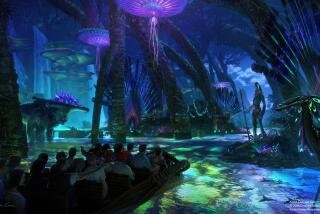Studio’s growth focuses on 3-D
- Share via
DreamWorks Animation SKG Inc., creator of the hit “Shrek” films, is bulking up in a big way.
The company this week will begin an $85-million project to expand its 13-acre Glendale studio, adding 100,000 square feet of new production space and more than 500 jobs in the next two years.
DreamWorks is growing quickly at a time when many other Los Angeles-area film companies are cutting back in the face of a sputtering economy and a slowdown in film production, delays partly caused by difficult contract talks between studios and Hollywood’s biggest actors union.
The new construction largely reflects the company’s ambitious entry into 3-D filmmaking, as well as the enduring popularity of family-oriented computer-animated films.
“The business is flourishing and there is a good reason for [DreamWorks] to be hiring so many people,” said Ron Diamond, co-founder of Animation World Network, an animation publishing group. “This is a very positive time for animators.”
Although some independently produced animated movies have misfired, the leading studios continue to reap big rewards from such films and the merchandising revenue they bring in. Walt Disney Co.’s Pixar Animation Studios scored another hit this summer with “Wall-E,” which has grossed more than $212 million domestically.
DreamWorks’ “Kung Fu Panda” has become its second-most successful film behind “Shrek 2,” grossing more than $560 million worldwide.
Calling the “Kung Fu Panda” box-office take “a significant achievement,” Wedbush Morgan Securities last week raised its third-quarter earnings estimates for the company. DreamWorks shares, which closed Friday at $31.04, have climbed more than 20% this year after falling 13% last year.
The studio, which typically produces two or three animated movies a year, has seven films in production, including “Monsters vs. Aliens,” set for release in March and a sequel to “Madagascar” due out in November. The company also is in talks to produce a sequel to “Kung Fu Panda.”
“We drew the right straw,” DreamWorks Animation Chief Executive Jeffrey Katzenberg said. “We’re in the one part of the entertainment business that just continues to show tremendous growth, in the international market in particular.”
With a growing pipeline of movies, the company needs more space to support a workforce that has grown by several hundred in recent years. The company now employs 1,700, including more than 400 at its PDI/DreamWorks facility in Northern California.
The new production space will be added onto the existing Lakeside Building, which will be renovated. The new facility will house as many as 600 additional digital artists, effects specialists, lighters and technologists with annual salaries of $100,000 to $150,000, the company said.
One goal in the construction and renovation plan is to modernize a campus that was built for the old hand-drawn style of animation, where artists worked in assembly-line fashion, often in separate buildings. Today’s digital animation requires simultaneous collaboration among different staffs.
“This will give us a better and more productive space to build a bigger pipeline of feature films,” Chief Operating Officer Ann Daly said.
But the primary impetus for the expansion is the company’s transition to 3-D.
Beginning with “Monsters vs. Aliens,” DreamWorks plans to produce both conventional computer-generated imagery and 3-D versions of its movies.
That requires more people because animators in effect have to render two sets of images, ensuring that frames have proper depth and aren’t jarring to the eye. Among other things, the studio is adding special rooms equipped with mobile cameras that enable filmmakers to experiment with shots in a digital setting.
DreamWorks executives say the new approach will raise the average budget of an animated movie 10% to $165 million. But executives believe that the investment in 3-D will pay off.
“It changes the experience for moviegoers, it changes the movie theater environment and it changes the artistic tools that storytellers and filmmakers have,” said Katzenberg, a champion of 3-D.
He called it “the biggest thing that’s come out in our lifetime in movies.”
Whether that proves true remains to be seen.
At least 10 3-D digital features are planned for 2009, but the rollout has been slow, largely because of the high cost of converting to digital projectors in theaters. So far, only about 1,100 screens are 3-D ready in North America.
Katzenberg, who had hoped that 5,000 screens would be converted by next March for the release of “Monsters vs. Aliens,” said he wasn’t troubled by the slow pace. He predicts the film will still make a “very good return” even with as few as 2,500 3-D screens and that by 2010, when the fourth installment of the Shrek franchise is released, as much as 80% of admissions will come from 3-D viewings.
Other studios also are banking heavily on the future of 3-D.
Disney, a pioneer of the new format, has said that all of its computer animated movies, including its upcoming feature, “Bolt,” will be released in digital 3-D. Another high-profile release expected next year will be James Cameron’s “Avatar” from 20th Century Fox.
“All of these companies,” Katzenberg said, “are investing in our future.”
--
--
(BEGIN TEXT OF INFOBOX)
Coming attractions
Movies from DreamWorks Animation and their release dates.
“Madagascar: Escape 2 Africa”
Nov. 7, 2008
“Monsters vs. Aliens”
March 27, 2009
“How to Train Your Dragon”
March 26, 2010
“Shrek Goes Fourth”
May 21, 2010
“Master Mind”
Nov. 5, 2010
More to Read
The biggest entertainment stories
Get our big stories about Hollywood, film, television, music, arts, culture and more right in your inbox as soon as they publish.
You may occasionally receive promotional content from the Los Angeles Times.











